
|
John A. Weeks III
Sunday, December 7, 2025, 7:59:16 PM CST |
|||
| Home | Photo Tours | Rail Fan | 12 Easy Steps |
| Aviation | Spacecraft | Highways & Bridges | About The Author |

|
|
|||||||||||||||||
Transcontinental Railroad MythsA Discussion Of Several Common Myths
|
| 1 | The Transcontinental Railroad was completed when the Central Pacific line was joined with the Union Pacific line in Utah. |
Not true. There was no bridge over the Missouri River connecting the Union Pacific Railroad to the east coast railroad network. As a result, there was no continuous line from the east coast to the west coast. Passengers traveling west had to get off of the train in Council Bluffs, take a stage coach and a ferry boat across the river into Omaha, then get back on the train. The Union Pacific did attempt to run trains on an ice bridge in the winter, but shifting ice and fluctuating water levels doomed this to being a futile effort.
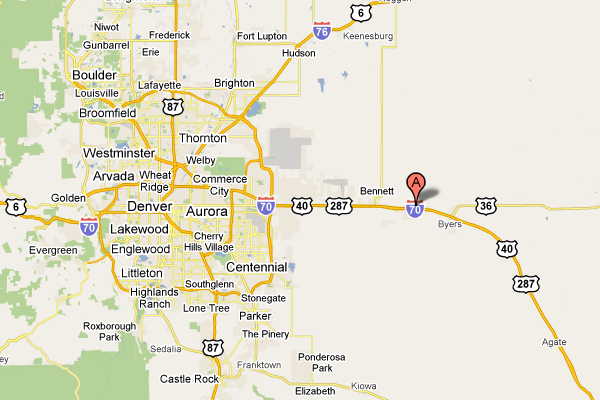
The west coast railroad link was a significant factor in Kansas City becoming the major railroad center west of Chicago. It was also a factor in Omaha not becoming that major hub. The Union Pacific did eventually get a connection to the east coast rail network via Council Bluffs when the first Union Pacific Missouri River Bridge was completed on March 25, 1873. The UP later purchased the Kansas Pacific Railway in 1880 to ensure its place in the Kansas City railroad market.
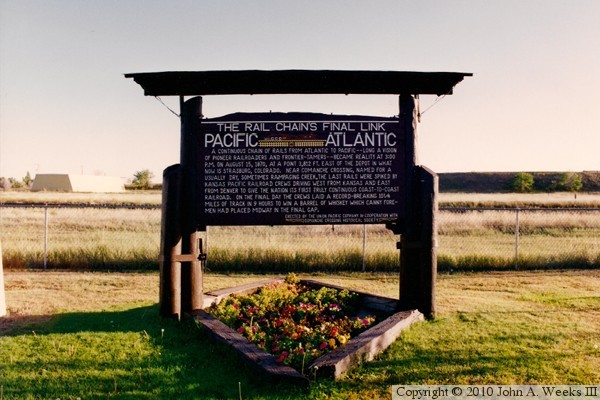
“A continuous chain of rails from Atlantic to Pacific--long a vision of pioneer railroaders and frontier-tamers--became reality at 3:00 P.M. on August 15, 1870, at a point 3,812 ft. east of the depot in what now is Strasburg, Colorado. Near Comanche Crossing, named for a usually dry, sometimes rampaging creek, the last rails were spiked by Kansas Pacific Railroad crews driving west from Kansas City and east from Denver to give the nation its first truly continuous coast-to-coast railroad. On the final day the crews laid a record-breaking 10-1/4 miles of track in 9 hours to win a barrel of whiskey which canny foremen had placed midway in the final gap.”
The text on the marker below reads as follows:
“Erected by Union Pacific Railroad in commemoration of Comanche Crossing Centennial marking point where rails were joined on August 15, 1870 to form the first continuous land link by railroad across the U.S.”
This marker might have been at that location at one point in the past, but when I visited in 1994, it was located at the local historical museum. You can see the same utility shed in the background of both photos.
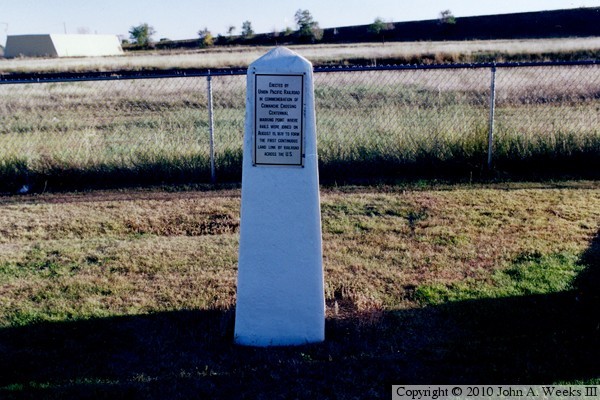
| 2 | The Central Pacific line was joined with the Union Pacific line at Promontory Point, Utah. |
Not true. The meeting place was Promontory Summit, not Promontory Point. As can be seen in the map below, clipped from Google Maps, Promontory Point is almost 30 miles south of the Golden Spike site. This mistake likely came about because this area is so barren that Promontory Point is one of the few points to be labeled on many maps.
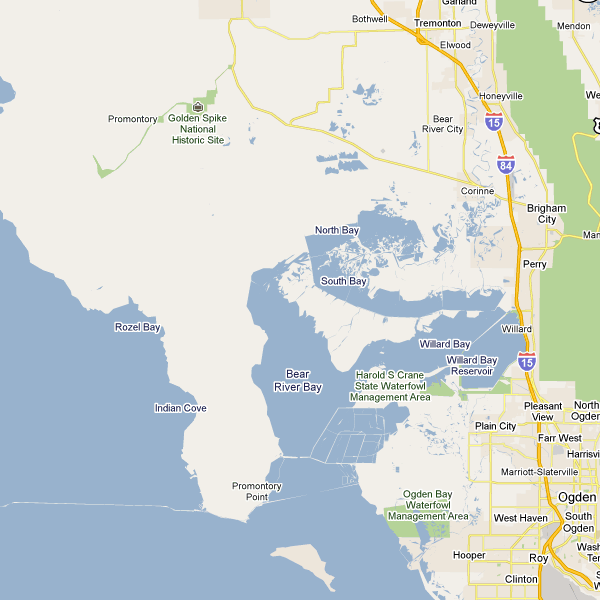
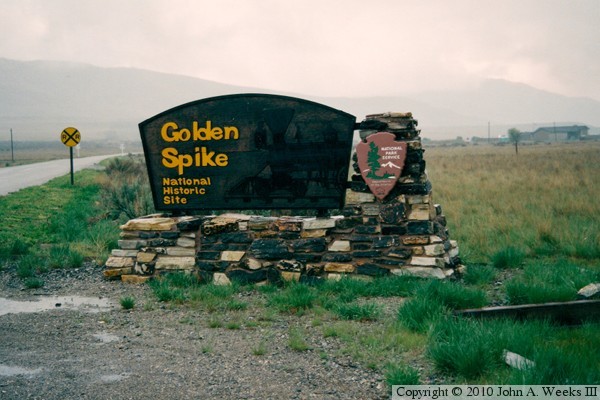
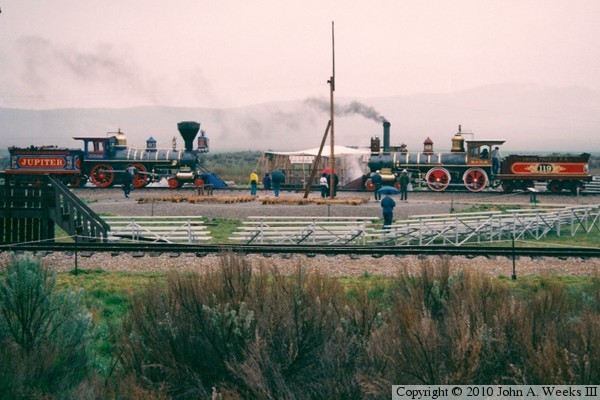
These locomotives are replicas of the originals. The originals were both scrapped in the early 1900s. The replicas were commissioned by the National Park Service in 1975 and went into service on May 10, 1979, just in time to participate in the 110th Anniversary of the Gold Spike. They were built using period plans for an American style 4-4-0 locomotive, and they are dressed up exactly as the originals appear in photos of the 1869 ceremony.
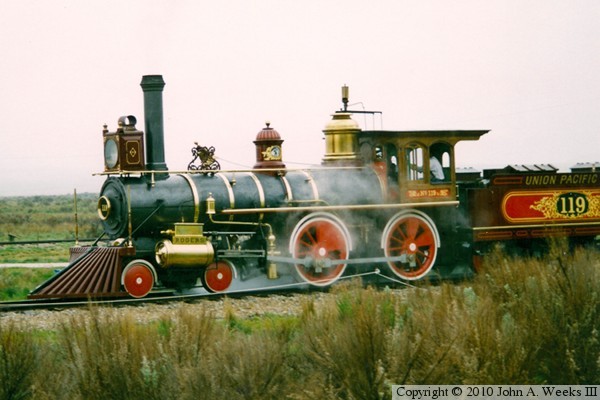
| 3 | The connection between the Central Pacific and the Union Pacific was completed when the Golden Spike was driven. |
Not true. The plan was that a ceremonial tie made out of Laurel (a type of wood) would be used for the ceremony. Later, the ceremonial spikes would be removed, returned to their owners, and a regular tie would be inserted. Then, normal railroad spikes would secure the rails to this final tie. As a result, a few hours after the Golden Spike was driven, the final tie was inserted and spiked in with ordinary iron spikes. History does not record who drove in the final spike, but it is very likely to have been a Chinese laborer.
| 4 | Leland Stanford drove in the Golden Spike. |
Not true. Gold would not have stood up to being struck by a railroad maul. The Laurel tie had holes bored in it for each of the four ceremonial spikes. The plan was that each spike would be dropped into the hole, and then officials would take turns tapping it with a silver-plated hammer. After the Golden Spike was inserted into its hole, several officials took turns tapping the spike. First was Stanford and Thomas Durant, who each missed once, then seven more attempts from Stanford, Durant, James Strobridge, and Samuel Reed. According to the California State Historical Society, it most likely was Reed who made the final tap on the Golden Spike. The spike itself shows no signs of having been hit with a hammer or any claw marks from removal, so it certainly wasn't driven in.
| 5 | ‘The Golden Spike’ implies that there was only one golden spike. |
Not true. There were actually four spikes that contained gold. This included a lower-grade gold spike, a blended spike containing gold, silver, and iron, the namesake high-grade gold spike, and a duplicate of the high-grade gold spike that was not present at the ceremony. In addition to these spikes, there was also a silver spike. As this was written, the golden spike was on display at Stanford University, and the duplicate was displayed at the California State Railroad Museum in Sacramento. The blended spike is on display at the Union Pacific Railroad Museum in Council Bluffs, Iowa.
|
|
Authored by John A. Weeks III, Copyright © 1996—2016, all rights reserved. For further information, contact: john@johnweeks.com
|